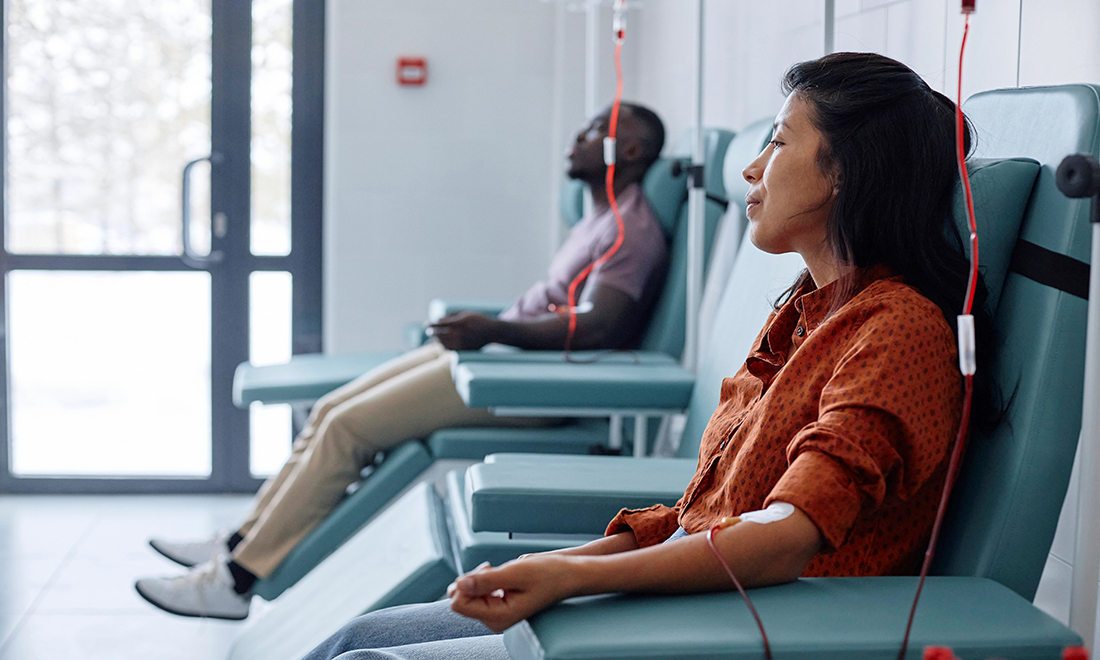实验室培育血液首次被输入人体

作为英国一项临床试验的一部分,科学家已经安全地将实验室培育的血液输注给人类,这是世界首例。
这一壮举是剑桥大学(University of Cambridge)和布里斯托尔大学(University of Bristol)的科学家以及英国国家医疗服务体系(National Health Service)的研究人员正在进行的一项研究的一部分,该研究将实验室培育的血液与来自同一捐献者的标准血液的寿命进行比较。
它是否安全?
这项研究背后的研究团队在11月7日宣布,人造血细胞是由从捐献者身上采集的干细胞培育而成的,到目前为止已经被输入两个人体内。
科学家们说,这标志着实验室培育的血细胞首次被输到一个人体内,而受血者并不是捐献者。
大约一茶匙到两茶匙,或5毫升到10毫升的实验室培育的血液被输到参与者体内。在常规输血中,病人要输的血比这多得多。
研究人员指出,受血者受到严密的监控,没有出现“不良”副作用的报告。专家说:“他们都很好,也很健康。”
随着试验的进行,至少10名参与者将接受两次“迷你输血”,一次是实验室培育的血液,另一次是标准的捐献血液,两次输血将至少间隔四个月。
科学家们将分析实验室中培育的“年轻”红细胞是否比体内产生的细胞寿命更长。
比“真”血更好?
输血可以挽救生命,适用于各种情况,从治疗分娩后或严重事故大出血的人,到治疗镰状细胞病和某些类型的癌症患者。
参与这项研究的专家表示,由于实验室培育的血细胞都是新的,而直接从捐献者那里采集的血液是由不同年龄的捐献者的细胞组成的,他们预计实验室培育的血液寿命更长。
布里斯托尔大学的阿什利·托伊教授和英国国家医疗服务体系血液和移植研究部(NHS Blood and Transplant)在一段概述该试验及其目标的视频中说,由于实验室培育的细胞“非常新鲜,能够随时使用”,因此研究团队希望实验室培育的细胞表现会更好。
有可能“彻底改变”治疗方法
研究人员于11月7日承认,在实验室培育的血液被推广医用之前,还需要进行进一步的试验,但他们表示,他们的研究标志着使用实验室培育的血液来改善“复杂输血需求”患者的治疗方法迈出了“重要”一步。
他们在一份新闻稿中说:“如果被证明是安全有效的,人造血细胞就可以彻底改变血液疾病患者的治疗方法,例如镰状细胞病和稀有血型患者。”
“对于一些患有这些疾病的人来说,可能很难找到足够的匹配的捐献血液。此外,如果人造细胞在体内的存活时间更长,经常需要输血的患者可能就不需要那么频繁地输血了。这将减少频繁输血导致的铁超载,而铁超载可能会导致严重的并发症。”
英国国家医疗服务体系血液和移植部的输血医学主任法鲁克·沙阿于11月7日在一份声明中解释称,需要定期或间歇性输血的患者会产生针对稀有血型的抗体,从而更难找到能够输血给这些人而又不会造成潜在威胁生命的反应的供血。
她说:“这项世界领先的研究为制造红细胞奠定了基础,这种红细胞可以安全地用于给镰状细胞病等疾病患者输血。绝大多数输血仍然需要正常献血。但是这项工作使难以接受输血的病人受益的潜力非常大。”
英国镰状细胞病协会(Sickle Cell Society)的首席执行官约翰·詹姆斯在一份声明中指出,虽然这项研究提供了“真正的希望”,但重要的是要记住,英国国家医疗服务体系仍然依赖每天250人献血来治疗镰状细胞病患者。
他说:“绝大多数输血仍然需要正常献血。”(财富中文网)
译者:中慧言-王芳
作为英国一项临床试验的一部分,科学家已经安全地将实验室培育的血液输注给人类,这是世界首例。
这一壮举是剑桥大学(University of Cambridge)和布里斯托尔大学(University of Bristol)的科学家以及英国国家医疗服务体系(National Health Service)的研究人员正在进行的一项研究的一部分,该研究将实验室培育的血液与来自同一捐献者的标准血液的寿命进行比较。
它是否安全?
这项研究背后的研究团队在11月7日宣布,人造血细胞是由从捐献者身上采集的干细胞培育而成的,到目前为止已经被输入两个人体内。
科学家们说,这标志着实验室培育的血细胞首次被输到一个人体内,而受血者并不是捐献者。
大约一茶匙到两茶匙,或5毫升到10毫升的实验室培育的血液被输到参与者体内。在常规输血中,病人要输的血比这多得多。
研究人员指出,受血者受到严密的监控,没有出现“不良”副作用的报告。专家说:“他们都很好,也很健康。”
随着试验的进行,至少10名参与者将接受两次“迷你输血”,一次是实验室培育的血液,另一次是标准的捐献血液,两次输血将至少间隔四个月。
科学家们将分析实验室中培育的“年轻”红细胞是否比体内产生的细胞寿命更长。
比“真”血更好?
输血可以挽救生命,适用于各种情况,从治疗分娩后或严重事故大出血的人,到治疗镰状细胞病和某些类型的癌症患者。
参与这项研究的专家表示,由于实验室培育的血细胞都是新的,而直接从捐献者那里采集的血液是由不同年龄的捐献者的细胞组成的,他们预计实验室培育的血液寿命更长。
布里斯托尔大学的阿什利·托伊教授和英国国家医疗服务体系血液和移植研究部(NHS Blood and Transplant)在一段概述该试验及其目标的视频中说,由于实验室培育的细胞“非常新鲜,能够随时使用”,因此研究团队希望实验室培育的细胞表现会更好。
有可能“彻底改变”治疗方法
研究人员于11月7日承认,在实验室培育的血液被推广医用之前,还需要进行进一步的试验,但他们表示,他们的研究标志着使用实验室培育的血液来改善“复杂输血需求”患者的治疗方法迈出了“重要”一步。
他们在一份新闻稿中说:“如果被证明是安全有效的,人造血细胞就可以彻底改变血液疾病患者的治疗方法,例如镰状细胞病和稀有血型患者。”
“对于一些患有这些疾病的人来说,可能很难找到足够的匹配的捐献血液。此外,如果人造细胞在体内的存活时间更长,经常需要输血的患者可能就不需要那么频繁地输血了。这将减少频繁输血导致的铁超载,而铁超载可能会导致严重的并发症。”
英国国家医疗服务体系血液和移植部的输血医学主任法鲁克·沙阿于11月7日在一份声明中解释称,需要定期或间歇性输血的患者会产生针对稀有血型的抗体,从而更难找到能够输血给这些人而又不会造成潜在威胁生命的反应的供血。
她说:“这项世界领先的研究为制造红细胞奠定了基础,这种红细胞可以安全地用于给镰状细胞病等疾病患者输血。绝大多数输血仍然需要正常献血。但是这项工作使难以接受输血的病人受益的潜力非常大。”
英国镰状细胞病协会(Sickle Cell Society)的首席执行官约翰·詹姆斯在一份声明中指出,虽然这项研究提供了“真正的希望”,但重要的是要记住,英国国家医疗服务体系仍然依赖每天250人献血来治疗镰状细胞病患者。
他说:“绝大多数输血仍然需要正常献血。”(财富中文网)
译者:中慧言-王芳
Lab-grown blood has safely been given to humans via transfusions as part of a British clinical trial, an achievement being hailed as a world first.
The feat came as part of an ongoing study being carried out by scientists at the universities of Cambridge and Bristol as well as researchers from the U.K.’s National Health Service (NHS), which is comparing the life span of lab-grown blood with standard blood that has come from the same donor.
Is it safe?
The manufactured blood cells—grown from stem cells that were collected from donors—have so far been transfused into two people, the research team behind the study announced on November 7.
It marks the first time lab-grown blood cells have been put into the body of someone who is not the donor of the cells from which the blood was grown, scientists said.
Around one to two teaspoons, or 5 to 10 milliliters, of lab-grown blood was transfused into the participants. In a regular blood transfusion, patients are given much more blood than this.
The recipients of the blood were being closely monitored, researchers noted, and no “untoward” side effects had been reported. “They are well and healthy,” experts said.
At least 10 participants will receive two “mini transfusions” of blood—one consisting of lab-grown blood, one of standard donated blood—as the trial progresses, which will be given a minimum of four months apart.
Scientists will analyze whether the “young” red blood cells made in the lab last longer than cells made in the body.
Better than “real” blood?
Blood transfusions can be lifesaving procedures and are used in various circumstances, from treating people who have suffered severe bleeding after childbirth or a serious accident to treating those with sickle cell disease and certain types of cancer.
Experts working on the study said that because the lab-grown blood cells were all new, while blood collected directly from donors was made up of cells of varying ages, they expected the lab-grown blood to have longer life spans.
In a video outlining the trial and its aims, professor Ashley Toye of the University of Bristol and NHS Blood and Transplant’s research unit said the team was hopeful that because the lab-made cells were “so freshly made and ready to go,” they would perform better.
Potential to “revolutionize” treatments
Researchers acknowledged on November 7 that further trials were needed before lab-grown blood could be rolled out for medical use, but they said their study marked a “significant” step toward using it to improve treatments for patients with “complex transfusion needs.”
“If proved safe and effective, manufactured blood cells could in time revolutionize treatments for people with blood disorders such as sickle cell and rare blood types,” they said in a press release.
“It can be difficult to find enough well-matched donated blood for some people with these disorders. Additionally, if manufactured cells last longer in the body, patients who regularly need blood may not need transfusions as often. That would reduce iron overload from frequent blood transfusions, which can lead to serious complications.”
Farrukh Shah, medical director of transfusion for NHS Blood and Transplant, explained in a statement on November 7 that patients who need regular or intermittent blood transfusions can develop antibodies against minor blood groups, making it more difficult to find donor blood that can be transfused into those individuals without the risk of a potentially life-threatening reaction.
“This world-leading research lays the groundwork for the manufacture of red blood cells that can safely be used to transfuse people with disorders like sickle cell,” she said. “The need for normal blood donations to provide the vast majority of blood will remain. But the potential for this work to benefit hard-to-transfuse patients is very significant.”
John James, chief executive of the U.K.’s Sickle Cell Society, said in a statement that while the research offered “real hope,” it was important to remember that Britain’s NHS still relied on 250 blood donations per day to treat people with sickle cell disorder.
“The need for normal blood donations to provide the vast majority of blood transfusions will remain,” he said.













